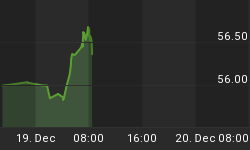Zero Hedge, citing a Federal Reserve Bank of New York report on ![]() Shadow Banking, makes (without even realizing it) a sure-fire case for deflation.
Shadow Banking, makes (without even realizing it) a sure-fire case for deflation.
I encourage you to visit the link shown above, but also take a look at On The Verge Of A Historic Inversion In Shadow Banking by Zero Hedge.
Here is the introduction by ZH.
While everyone's attention was focused on details surrounding the household sector in the recently released Q1 Flow of Funds report (ours included), something much more important happened in the US economy from a flow perspective, something which, in fact, has not happened since December of 1995, when liabilities in the deposit-free US Shadow Banking system for the first time ever became larger than liabilities held by traditional financial institutions, or those whose funding comes primarily from deposits.
As a reminder, Zero Hedge has been covering the topic of Shadow Banking for over two years, as it is our contention that this massive, and virtually undiscussed component of the US real economy (that which is never covered by hobby economists' three letter economic theories used to validate socialism, or even any version of (neo-)Keynesianism as shadow banking in its proper, virulent form did not exist until the late 1990s and yet is the same size as total US GDP!), is, on the margin, the most important one: in fact one that defines, or at least should, monetary policy more than most imagine, and also explains why despite trillions in new money having been created out of thin air, the flow through into the general economy has been negligible.
Empirical Proof of Deflation
Here are the pertinent charts and commentary.

That chart is from the NY Fed.
On a similar chart ZH commented ... "As another reminder, US Shadow Banking liabilities - a combination of Money Market funds, GSE and Agency paper, Asset-Backed paper, Funding Corporations, Open market paper and of course, Repos - hit a gargantuan $21 trillion in March 2008. They have tumbled ever since, printing at just under $15 trillion at the end of March 2012, the lowest number since March 2005 when shadow banking liabilities were soaring. This is an epic $6 trillion in flow being taken out of credit-money circulation, with a $143 billion drop in Q1 alone!"
Sequential Change in Shadow Bank Liabilities
The chart immediately above is from ZH, not the NY Fed article.
ZH comments ... "It is precisely this ongoing contraction that the Fed does all it can, via traditional financial means, to plug as continued declines in Shadow Banking notionals lead to precisely where we are now - a sideways "Austrian" market, in which no new credit-money money comes in or leaves."
Emphasis in bold by ZH.
Deflation It Is
There is nothing "sideways" about it. The charts clearly show credit money is indeed leaving (contracting) to the tune of a whopping $6 trillion since March 2008.
Interestingly, Zero Hedge did not mention "deflation" once in his post.
Yet, those charts, without a doubt, depict deflation if one accurately describes inflation and deflation as measures of credit, not prices.
Based on real-world experience of what is most important, here is my definition: Inflation is a net increase of money supply and credit with credit marked to market.
Deflation is the opposite, a net decrease of money supply and credit with credit marked to market.
If one woodenly sticks to the view that inflation and deflation are about prices (while ignoring a devastating collapse in housing), then yes, the US is still in a period of inflation.
Likewise, if one foolishly sticks to measures of money supply like M1, M2, or TMS (true money supply) by Michael Pollaro, then the US is also in a period of inflation.
Real World Viewpoint
Neither money supply nor the CPI can adequately explain interest rates, housing prices, lack of jobs, and numerous other real-world phenomena.
In the real-world, in a credit-based economy, it is credit that matters.
The above charts show the real story. That story explains 10-year treasury yields at 1.61% and 2-year yields at .29% even though the CPI is 1.7% year-over-year.
Those charts also show why hyperinflationists are in an alternate universe and why proponents of "huge inflation but not hyperinflation" are on Mars.
















